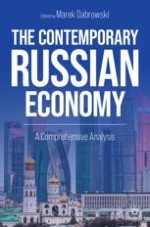2023 | OriginalPaper | Buchkapitel
9. Energy Sector
verfasst von : Przemyslaw Kowalski
Erschienen in: The Contemporary Russian Economy
Aktivieren Sie unsere intelligente Suche, um passende Fachinhalte oder Patente zu finden.
Wählen Sie Textabschnitte aus um mit Künstlicher Intelligenz passenden Patente zu finden. powered by
Markieren Sie Textabschnitte, um KI-gestützt weitere passende Inhalte zu finden. powered by
